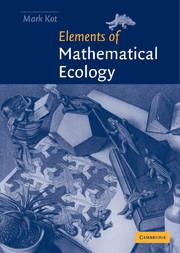Book contents
- Frontmatter
- Contents
- Preface
- Acknowledgments
- I UNSTRUCTURED POPULATION MODELS
- 1 Exponential, logistic, and Gompertz growth
- 2 Harvest models: bifurcations and breakpoints
- 3 Stochastic birth and death processes
- 4 Discrete-time models
- 5 Delay models
- 6 Branching processes
- 7 A classical predator-prey model
- 8 To cycle or not to cycle
- 9 Global bifurcations in predator–prey models
- 10 Chemostat models
- 11 Discrete-time predator–prey models
- 12 Competition models
- 13 Mutualism models
- 14 Harvest models and optimal control theory
- II STRUCTURED POPULATION MODELS
- References
- Author index
- Subject index
6 - Branching processes
Published online by Cambridge University Press: 05 August 2012
- Frontmatter
- Contents
- Preface
- Acknowledgments
- I UNSTRUCTURED POPULATION MODELS
- 1 Exponential, logistic, and Gompertz growth
- 2 Harvest models: bifurcations and breakpoints
- 3 Stochastic birth and death processes
- 4 Discrete-time models
- 5 Delay models
- 6 Branching processes
- 7 A classical predator-prey model
- 8 To cycle or not to cycle
- 9 Global bifurcations in predator–prey models
- 10 Chemostat models
- 11 Discrete-time predator–prey models
- 12 Competition models
- 13 Mutualism models
- 14 Harvest models and optimal control theory
- II STRUCTURED POPULATION MODELS
- References
- Author index
- Subject index
Summary
In Chapter 3, I introduced birth and death processes as the stochastic analogs of simple differential equations. In a similar spirit, one can ask for a stochastic counterpart to the simple linear difference equation,
that I introduced at the start of Chapter 4.
Earlier, we imagined that each individual left R0 offspring. Let us now follow the lead of the Reverend H. W. Watson and of Francis Galton (1874), as paraphrased by Harris (1963), and introduce an element of chance into this formula:
Let p0, p1p2, … be the respective probabilities that a man has 0, 1, 2,… sons, let each son have the same probability for sons of his own, and so on. What is the probability that the male line is extinct after r generations, and more generally what is the probability for any given number of descendants in the male line in any given generation?
Watson and Galton were interested in the extinction of family names. But to solve their problem, we must develop a generation-by-generation description of the growth of an arbitrary population. In particular, we must determine the population's size, Nt, in each generation t. The problem is challenging in that Nt is now a random variable with a discrete parameter (time) and a countable state space. The Galton–Watson process is a simple, discrete, branching process.
- Type
- Chapter
- Information
- Elements of Mathematical Ecology , pp. 93 - 106Publisher: Cambridge University PressPrint publication year: 2001



